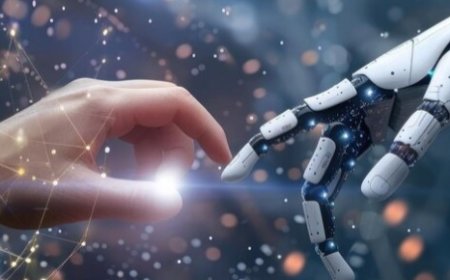The Future of Human-Machine Interaction
Explore the future of human-machine interaction, where technology and humans seamlessly collaborate. Discover the latest trends and insights.

In the dynamic landscape of technological advancement, the future of human-machine interaction (HMI) is a captivating journey into a realm where innovation and connection converge. As we stand on the precipice of a new era, marked by artificial intelligence, augmented reality, and advanced robotics, the way humans interact with machines is undergoing a profound transformation.
The Rise of Artificial Intelligence
Artificial Intelligence (AI) stands as the cornerstone of the future of human-machine interaction, propelling us into an era where machines not only comprehend but learn and adapt. At its essence, AI involves the development of algorithms that enable machines to simulate human intelligence, learning from vast datasets and making decisions with minimal human intervention. The current trajectory of AI development suggests a seismic shift in how we interact with technology.
In the realm of HMI, AI's rise is most palpable in the evolution of virtual assistants and predictive technologies. Systems like Siri, Alexa, and Google Assistant have become ubiquitous, transforming how we perform everyday tasks. These virtual companions leverage natural language processing and machine learning to understand and respond to user commands, creating an environment where communication with machines mimics human conversation.
Moreover, AI's influence extends beyond voice-activated assistants. Recommendation systems on streaming platforms and e-commerce websites utilize complex algorithms to predict user preferences, offering personalized content and suggestions. This not only enhances user experience but also exemplifies the power of AI in understanding and adapting to individual behaviors.
In industries like healthcare and finance, AI is proving to be a game-changer. Machine learning algorithms analyze medical data to identify patterns and assist in diagnostics, potentially revolutionizing patient care. In finance, AI algorithms sift through vast datasets to make real-time predictions, aiding in investment decisions and risk management.
Augmented and Virtual Reality
Augmented Reality (AR) and Virtual Reality (VR) are revolutionary technologies that are reshaping the way we perceive and interact with the world around us. Augmented Reality enhances our real-world environment by overlaying digital information onto it, creating a blended experience where virtual and physical elements coexist. On the other hand, Virtual Reality immerses users in a completely digital environment, shutting out the real world and offering a simulated reality.
In Augmented Reality, users experience an amalgamation of the physical and virtual realms through devices like smartphones, smart glasses, or AR headsets. Imagine walking down the street and receiving real-time information about landmarks, restaurants, or historical facts seamlessly displayed on your smart glasses. AR has found applications in various fields, from gaming and education to healthcare and retail, offering users contextual information in real time.
Virtual Reality, on the other hand, transports users to entirely different worlds. VR headsets, often equipped with motion-tracking sensors, provide a fully immersive experience by blocking out the external environment. Users can find themselves exploring distant planets, participating in lifelike simulations, or even undergoing virtual training. VR has proven to be a game-changer in industries like gaming, healthcare, and education, offering unparalleled experiences that were once confined to the realm of science fiction.
Natural Language Processing and Conversational Interfaces
Natural Language Processing (NLP) is a branch of artificial intelligence that focuses on enabling machines to understand, interpret, and generate human language in a way that is both meaningful and contextually relevant. The goal of NLP is to bridge the gap between human communication and computer understanding. Through the use of advanced algorithms and linguistic models, NLP allows machines to process and analyze vast amounts of textual data, making it possible for them to comprehend language nuances, and sentiment, and even infer meaning from context. NLP has far-reaching applications, from language translation and sentiment analysis to chatbots and voice recognition systems.
-
Conversational Interfaces
Conversational interfaces are user interfaces that enable natural language-based communication between humans and machines. These interfaces leverage NLP to facilitate seamless interactions, allowing users to engage with technology in a conversational manner, similar to how they would communicate with another person. Chatbots, virtual assistants, and voice-activated systems are common examples of conversational interfaces. These interfaces are designed to understand user queries, respond appropriately, and, in some cases, perform tasks or provide information. The aim is to make interactions with machines more intuitive and user-friendly, reducing the need for users to learn complex commands or navigate through rigid menu structures.
-
Integration of NLP and Conversational Interfaces
The integration of NLP with conversational interfaces is a powerful synergy that brings a human touch to human-machine interactions. NLP enables machines to understand the intricacies of human language, while conversational interfaces provide a platform for users to engage with machines in a manner that feels natural and intuitive. This combination is evident in applications like virtual assistants (e.g., Siri, Alexa, Google Assistant) that not only recognize spoken words but also interpret user intent and respond in a conversational manner. As NLP continues to advance, conversational interfaces are becoming more sophisticated, enabling more fluid and context-aware interactions.
Robotics and Human Collaboration
In the realm of technological evolution, the collaboration between robotics and humans stands out as a pivotal frontier. The vision of robots working alongside humans was once confined to the realms of science fiction, but it has now become an integral part of our reality. The essence of this collaboration lies in harnessing the unique strengths of both entities to create a synergy that amplifies productivity and efficiency.
At the heart of this collaboration is the idea that robots can undertake tasks that are repetitive, dangerous, or require precision, allowing humans to focus on more complex and creative endeavors. In industrial settings, this collaboration has been particularly transformative. Robots, equipped with advanced sensors and precision controls, can perform intricate tasks with unmatched accuracy, while human workers bring creativity, problem-solving skills, and adaptability to the table.
In healthcare, the collaboration between robotics and humans has ushered in a new era of patient care. Robots can assist surgeons in delicate procedures, enhancing precision and reducing the margin of error. Telepresence robots enable doctors to remotely diagnose and interact with patients, breaking down geographical barriers and ensuring access to medical expertise in remote areas.
Ethical Considerations and Privacy Concerns
Ethical Considerations:
-
Algorithmic Bias: Concerns arise when algorithms in AI systems exhibit bias based on race, gender, or other sensitive attributes, potentially perpetuating societal inequalities.
-
Autonomous Decision-Making: As machines make decisions autonomously, ethical questions emerge about accountability and responsibility when things go wrong.
-
Transparency: Lack of transparency in AI systems can make it challenging to understand how decisions are made, leading to distrust and ethical concerns.
-
Human Replacement: Automation and AI-driven systems can lead to job displacement, raising questions about the ethical responsibility of companies and governments to support affected workers.
Privacy Concerns
-
Data Security: The collection and storage of personal data by machines raise concerns about data breaches and unauthorized access.
-
Surveillance: The use of AI-powered surveillance systems, such as facial recognition, can infringe upon personal privacy and civil liberties.
-
Informed Consent: Obtaining informed consent for data collection and use becomes more challenging as AI systems process vast amounts of data in the background.
-
Profiling and Personalization: AI-driven profiling and personalized content raise concerns about the manipulation of user preferences and reinforcement of echo chambers.
Customization and Personalization
In the landscape of Human-Machine Interaction (HMI), customization and personalization stand out as key pillars shaping the future user experience. In essence, these concepts represent a departure from the one-size-fits-all approach, offering tailored interactions that cater to the unique preferences and needs of each individual.
Customization in HMI involves allowing users to modify the interface, features, and settings according to their preferences. This level of flexibility empowers users to create an environment that aligns perfectly with their habits and expectations. From adjusting the color scheme of an application to choosing specific functionalities, customization puts the user in the driver's seat, fostering a sense of ownership over the technology they interact with daily.
On the other hand, personalization takes customization a step further by leveraging advanced technologies such as Artificial Intelligence (AI) to understand user behavior and preferences. AI algorithms learn from user interactions, analyzing data to predict future needs and adapt the interface accordingly. This dynamic approach ensures a highly personalized experience, where the technology not only responds to current preferences but anticipates them, creating a seamless and intuitive interaction.
The future of human-machine interaction is a tapestry woven with threads of innovation, connectivity, and challenges. As we navigate this evolving landscape, it is imperative to approach the development and integration of HMI technologies with a thoughtful and ethical mindset. The potential benefits are immense, from enhanced productivity to enriched human experiences. By embracing the possibilities while addressing the associated challenges, we can look forward to a future where human-machine interaction is not just intuitive but also transformative.











































